- Home
- Buddhist Temples
- Wat Phra Phutthabat
Wat Phra Phutthabat
Wat Phra Phutthabat, Saraburi is recognised as one of the top six Thailand Buddhist Temples and is well worth a visit on your next trip to Thailand.
It is located 190 Km to the north of Bangkok in Saraburi Province and about 20 Km outside of Lopburi.
Most of the drive is on the expressway or local roads so traffic should not be a problem, but if you don't have your own transport then
Wat Phra Phutthabat Day Trip
It is very easy to take a day trip over to Wat Phra Phutthabat as the drive is a leisurely 2.75 hours from Bangkok and it can easily be visited in a day.
There will even be time to take a side trip to Lopburi to see the Lopburi monkeys.
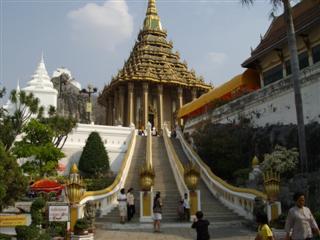
This large Buddhist temple was built in the 17th century after a representation of the Buddhas footprint was found in the limestone rock and it is considered one of Thai Buddhism's holiest of sites.
The 2 metre footprint was declared a footprint of Buddha and the temple was built around it.
The local district was given the name Phra Phutthabat.
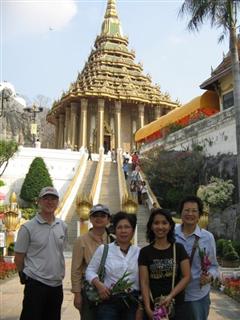
At the entrance to the temple you are greeted with huge stone steps in three separate staircases rising up the hill.
The sides of the staircases are flanked by Naga balustrades and at the base are bronze five headed Naga snakes, which you can just see directly behind the people's heads in the photograph above.
This three part stair case represents the three ladders used to descend from the Trayastrimsa Heaven.
One ladder of silver is used by Brahma, one ladder of jewels is used by the Buddha and one ladder of gold is used by Indra.
At the top of the stairs the two metre footprint is housed in a monodop, which is an ornately finished small building built to protect the holy object.
Visitors to Wat Phra Phutthabat come to the monodop to make merit and place gold leaf onto the foot print.
Unfortunately I don't have a picture of the monodop and footprint as I got separated from my group and was looking at the view and busy taking pictures of myself.
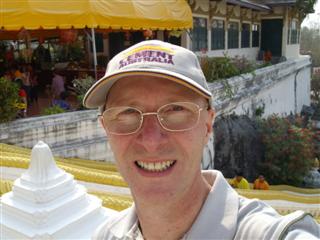
Wat Phra Phutthabat is located on the side of a hill and if you continue up the steps there are some other things worth seeing.
Although I didn't count the steps, I was told that there are about 225 that take you up to the rock face at the top.
In places the steps are fairly steep as you can see from the picture below, but the view from the top is worth the climb.
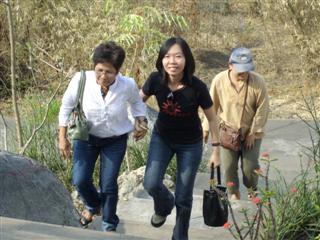
If the weather is hot you may need to take a rest on the way up.
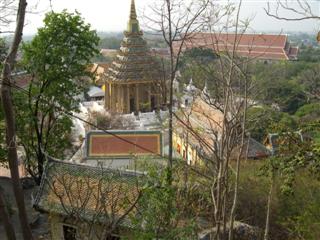
After you have climbed the 225 steps you will reach a small flat area that houses a Buddha image up against the cliff face.
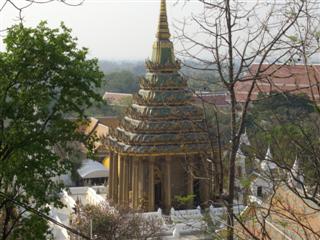
It is said that if you look long and hard at the rock face you can see the face of the Buddha.
You can buy gold leaf here to stick to the cliff face or to the Buddha image.
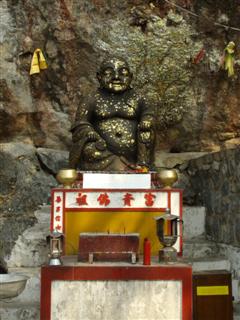
The walk down the steps is much easier than going up and on the way down you can see the Temple Bells.
Visitors to Wat Phra Phutthabat come and hit the bells one by one saying a prayer as they do so. It is supposed to bring them good luck.
From my photographs Wat Phra Phutthabat looks very quiet, but in fact there were many hundreds of people there that Saturday.
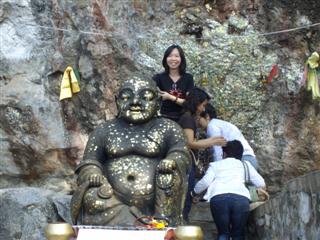
Down at the bottom of the mount is the Phra Phutthabat museum that tells the history of the temple and has interesting historic artifacts relating to the history of the Buddha footprint and how the temple originated.
As you leave the temple grounds and return to your vehicle, you walk through a small market area that has food and fruits that I didn't even recognise.
Interestingly I also spotted some hand carved walking sticks for about 100 baht each, extremely ornate and a bargain at that price.
I really could have done with seeing the walking sticks for sale before I climbed the steps.
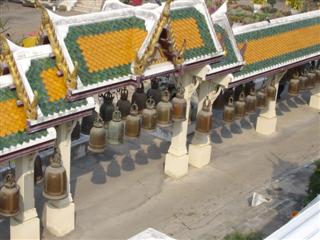
I enjoyed visiting this temple and am only sorry I missed the Buddha's footprint and I have added this Buddhist temple to my list of places to revisit in the future.
I don't recall paying any entrance fee to the temple, although some websites suggest that there is a small fee for entry.
Driving directions to Wat Phra Phutthabat
Using Google Maps
Visit to Lopburi Monkeys
After we left Wat Phra Phutthabat, we went on to visit the town of Lopburi, which has a different type of interest.
Lopburi is a small town with a population of approximately 27000 and is located just 17 km North West of Wat Phra Phutthabat.
Lopburi is the provincial capital of Lopburi Province and was previously the second capital, after Ayutthaya was established in 1350 AD.
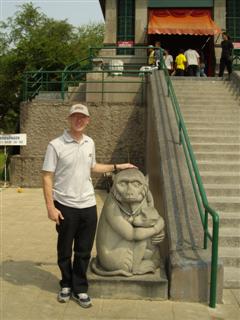
Previously it was an important centre of the Khmer empire.
Now its main tourist attraction is the presence of crab-eating macaque monkeys that inhabit the old town, but especially around the ruins of the Khmer temple Phra Phrang Sam Yot and Khmer shrine Phra Karn Shrine.
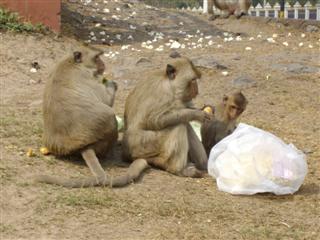
The Phra Karn Shrine is located in the middle of a roundabout and you have to negotiate the traffic to get to it.
Outside the entrance steps are a pair of stone carved macaque monkeys.
If you cross the road and the railway line you can visit the historic Phra Prang Sam Yot which has three prangs that represent Brahma, Vishnu, and Shiva (the Hindu trinity).
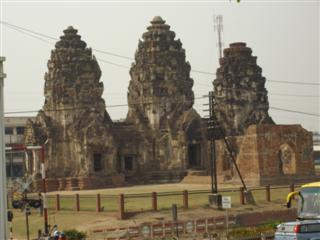
The monkeys stop frequently at the water trough located next to the railway line as they travel between the shrine and the temple whilst cleverly avoiding the road traffic.
Be careful of your possessions when the monkeys are around as they are not afraid of humans and they can quickly steal your handbag or purse.
Lopburi Monkey Festival
In the month of November there is a monkey festival, where the townsfolk put on a lavish buffet for the benefit of the monkeys.
In some way this is to thank the monkeys for the tourists that they bring to the town.
The idea to have a monkey festival started from a local businessman in the the 1980's and has continued ever since.
On the day of the banquet there are four separate servings of food for the monkeys, at 10:00, 12:00, 14:00 and 16:00.
It sounds a bit like feeding time at the zoo, doesn't it.
If you are thinking of coming to visit the Lopburi Monkey festival and wanting to stay overnight in the town, then it is advisable to book your accommodation ahead of time, to ensure you are not disappointed.
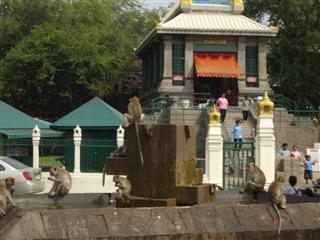
If you follow the railway line back across the road and walk through the car park there are ruins of another Khmer building.
Most of the walls of the ruins in Lopburi are not above head height and you can walk around the outside of them taking photographs of these amazing Buddhist temples as you go.
Start to Plan Your Bangkok Trip Now!
- Experience our Thai Cooking courses and expand your culinary skills.
- Explore a range of Things To Do In Bangkok - there are lots of activities and tours you can quickly book online or simply use as inspiration for your upcoming Bangkok travel.
- Don't forget to bring any of the essentials with our complete Packing List For Bangkok.
- Explore a range of Things To Do In Ayutthaya - there are loads of activities and tours you can quickly book online or simply use as inspiration for your upcoming Bangkok travel.
- Need inspiration? Check our Bangkok guide books for ideas of where to go and what to do. Download or read online.
- Experience a live Muay Thai boxing bout in Bangkok.
- Book a Bangkok airport transfer to take you direct from the airport to your hotel, with the driver meeting you in Arrivals.
- Experience Chinatown at night and go for an extravaganza of food tasting, whilst being whisked around in a traditional tuk-tuk.
- Find available Bangkok hotels on Agoda - best rates and free cancellations.
- Find the cheapest period to travel to Bangkok with Google Flights - one search will show you the prices and times from scores of airlines for your trip.
Earn Money in Retirement with SoloBuildIt!
Imagine working from anywhere, on your own terms, and generating income during retirement, doing what you love. SoloBuildIt makes this dream a reality, empowering you to:
- Create stunning websites: No coding required! Drag-and-drop your way to a professional website that showcases your skills and offerings.
- Sell anything online: Easily set up an online store to sell products, services, or even digital downloads.
- Attract new clients: Powerful marketing tools help you reach your target audience and convert visitors into paying customers.
- Work from anywhere: Manage your website and business from any device, with complete flexibility and freedom.
SoloBuildIt is more than just a website builder:
- All-in-one solution: Everything you need to succeed online is included, from website creation to marketing and sales tools.
- Step-by-step guidance: Learn at your own pace with comprehensive tutorials, webinars, and expert support.
- Thriving community: Connect with other SoloBuildIt users and gain valuable insights and inspiration.
Stop dreaming, start doing!
Take control of your future and start building your online retirement income stream today. Try SoloBuildIt and experience the power of having your own website.
Click here to start your trial and unlock your earning potential!
Affiliate Declaration: I am a SoloBuildit affiliate and can earn commissions from sales of this product. This income helps me produce content for this site.